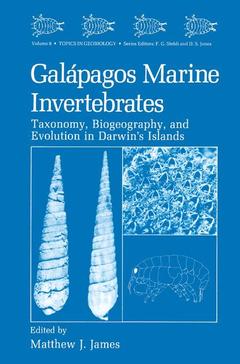Description
Galápagos Marine Invertebrates, Softcover reprint of the original 1st ed. 1991
Taxonomy, Biogeography, and Evolution in Darwin’s Islands
Topics in Geobiology Series, Vol. 8
Coordinator: James Matthew J.
Language: English
Subject for Galápagos Marine Invertebrates:
Keywords
Charles Darwin; Darwin; biogeography; development; ecology; evolution; invertebrates; zoogeography
Publication date: 06-2013
474 p. · 15.5x23.5 cm · Paperback
474 p. · 15.5x23.5 cm · Paperback
Description
/li>Contents
/li>
Marine Invertebrate Evolution in the Galapagos Islands MATTHEW J. JAMES 1. Perspective of This Volume . . . . . . . . . . . . . . . . . . . . . . . . . . . . . . . . . . . . . . . . . . . . . . . . . . . . . . . . . . . . . 1 2. Directions for Future Research . . . . . . . . . . . . . . . . . . . . . . . . . . . . . . . . . . . . . . . . . . . . . . . . . . . . . . . . . . 2 3. Plan of This Volume . . . . . . . . . . . . . . . . . . . . . . . . . . . . . . . . . . . . . . . . . . . . . . . . . . . . . . . . . . . . . . . . . . . 2 1. Perspective of This Volume Charles Darwin brought the Galapagos Islands to the attention of zoologists, botanists, and geologists following the six-week visit of H. M. S. Beagle to the islands in 1835. Since then published research on the biota of the islands, partic ularly in multiauthored volumes, has focused on terrestrial plants and animals. The present volume is designed specifically to provide a summary of work on the marine invertebrate fauna. One deviation from that objective was the inclusion of a chapter on land snails, which proved to be a good choice because the phylum Mollusca is now covered more thoroughly in this volume than in any single previous scholarly work on the Galapagos. The academic bottom line with this book is to elucidate the evolutionary responses of shallow water, benthic marine invertebrates to the unique set of insular conditions that exist in the Galapagos Islands. The route taken to that objective has many paths including taxonomic revision, determining biogeo graphic affinities, and examining the ecological requirements of species. The information presented here is for some groups from the islands the first stage in a thorough process that can eventually lead to an understanding of the phylogeneticrelationships of these species.
• Marine Invertebrate Evolution in the Galápagos Islands.- I. Oceanographic Setting.- 1 • The Galápagos Islands and Their Relation to Oceanographic Processes in the Tropical Pacific.- II. Meiofauna and Annelida.- 2 • The Meiofauna of the Galápagos: A Review.- 3 • The Polychaete Fauna of the Galápagos Islands.- III. Coelenterata.- 4 • El Niño and Coral Reef Development in the Galápagos Islands: A Study of the Urvina Bay Uplift.- IV. Arthropoda (Crustacea).- 5 • Taxonomy, Distribution, and Ecology of Galápagos Brachyura.- 6 • Caridean and Stenopodid Shrimp of the Galápagos Islands.- 7 • Biogeographic Patterns of the Galápagos Porcelain Crab Fauna.- 8 • Zoogeography of the Shallow-Water Cirriped Fauna of the Galápagos Islands and Adjacent Regions in the Tropical Eastern Pacific.- 9 • Amphipoda of the Galápagos Islands.- V. Marine Cave Fauna.- 10 • Anchialine Fauna of the Galápagos Islands.- VI. Mollusca.- 11 • The Marine Mollusks of the Galápagos: Determinants of Insular Marine Faunas.- 12 • The Marine Mollusks of the Galápagos Islands.- 13 • The Opisthobranch Gastropod Fauna of the Galápagos Islands.- 14 • Biogeography of Galápagos Land Snails.- 15 • Charles Darwin’s Contribution to the Molluscan Fauna of the Galápagos Islands: Historical Perspective on Endemicity and Biogeography.- VII. Echinodermata.- 16 • Echinoderm Fauna of the Galápagos Islands.- VIII. Bryozoa.- 17 • The Bryozoa of the Galápagos.- IX. Taphonomy and Paleoecology.- 18 • The Past as a Key to the Present: Taphonomy and Paleoecology of the Urvina Bay Uplift.- 19 • Taphonomy and Paleoecology of Villamil Fossil Megagastropods of Isla Isabela.- Systematic Index.
© 2024 LAVOISIER S.A.S.




